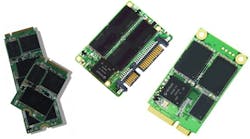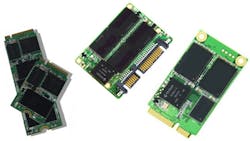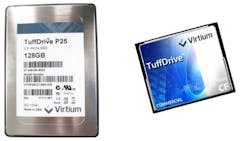Encrypted SSDs Take Aim at Industrial IoT Applications
Security has become increasingly important to industrial systems, and one aspect of that involves self-encrypting drives (SEDs). SEDs have been common on consumer devices like laptops and in the enterprise, but industrial drives have additional requirements to address rugged environments. It does not usually pay to incorporate a consumer SED—or even an enterprise SED—in an industrial or automotive setting.
Virtium is delivering its StorFly family of SEDs in a range of form factors, including board-based form factors like M.2, SlimSATA and mSATA (Fig. 1). The StorFly family also includes 2.5-in and 1.8-in drives as well as CompactFlash devices. SEDs allow a system to make the data inaccessible almost immediately.
The SED versions utilize Virtium’s vtSecure technology. This is based on AES-256 encryption. Drive-based encryption does not place additional computational burdens on the host. The devices are compatible with the Trusted Computing Group Opal 2.0 standard. This includes support for hardware- and software-initiated crypto-erase and block-erase to satisfy the requirements of the National Institute of Standards and Technology Special Publication 800-88 Revision 1 Guidelines for Media Sanitization.
StorFly devices also incorporate Virtium’s vtGuard Power Fail Protection. The vtGuard hardware support can detect a power failure, at which point it flushes RAM to a journaled flash block. The system is designed to check the journal when it starts up to complete any transactions that were taking place when power was lost.
The devices are supported by Virtium’s new vtView SSD software, which can determine remaining lifetime and track system usage. It also tracks data retention based on storage temperature. The software runs on Windows and Linux operating systems. In addition, it has an API for custom application access.
The StorFly family comes in three versions: CE, XE, and PE. The CE uses MLC flash memory with a three-year warranty, while XE use iMLC with a five-year warranty. The iMLC technology uses a combination of SLC and MLC to simultaneously deliver high capacity and improve endurance. The PE version also has a five-year warranty and is based on SLC flash memory. The CE version is designed to handle a full disk write per day for the warranty period; the XE has seven times that ability, and the PE has 30 times that ability. The CE is designed for 0º to 70ºC commercial applications. The other two can handle industrial applications from -40º to 85ºC.
Virtium’s TuffDrive solutions provide industrial performance without the self-encrypting technology. This allows developers to choose the level of sophistication needed for an application. These also come in the CE, XE, and PE media types.
The StorFly SED devices are available in capacities ranging from 8 Gbytes to 1 Tbyte depending upon the form factor.




